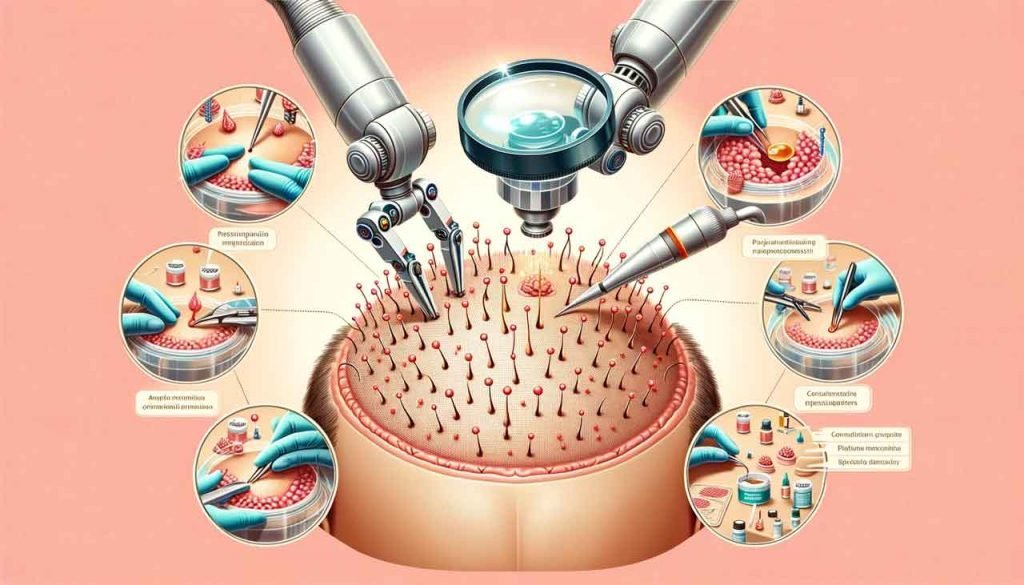Are you in the league of those battling the blues of hair loss? Have you ever daydreamed of a universe where your stem cells turn into a magic wand, conjuring up a mane that rivals a lion's? 🦁 Hey, guess what? That daydream isn't a galaxy far, far away anymore. Dive into the realm of the latest advancements in hair transplant: the stem cell magic show!
"So, how does this Harry Potter-esque trick work?" you might wonder. Who can sit on this magical hair throne? And more crucially, how safe is this enchanted ride? Relax, grab a comfy seat, and unravel these mysteries together. Embark on a journey that's set to redefine the narrative of hair restoration. Ready to wave goodbye to those receding hairlines and usher in a lush, thick, and oh-so-fabulous future? 🌟
Table of Contents

Understanding Stem Cell Hair Transplant
You're about to delve into the fascinating world of stem cell hair transplants, a revolutionary procedure designed to stimulate hair growth and combat hair loss. Imagine being part of a community embracing innovative hair loss solutions. Here's how it works: a small skin sample is taken from your scalp, and stem cells are derived from that. These cells are replicated in a laboratory and then implanted back into your scalp. This isn't just science fiction; it's happening now, and you could be part of it. Isn't it exciting? To be part of a solution that not only combats hair loss but also stimulates new growth in areas that need it most. You're not just fighting hair loss; you're promoting growth. Welcome to the future of hair restoration.
The Procedure of Stem Cell Hair Transplant
Let's delve into how a stem cell hair transplant procedure is conducted, shall we? First, your doctor takes a small skin sample from your scalp, using a specialized instrument for a punch biopsy. This is where the stem cells are derived. These cells are then replicated in a laboratory, creating more precious cells that are key to stimulating new hair growth. After this replication process, they're implanted back into your scalp, specifically in areas experiencing hair loss.
You're part of a revolutionary procedure advancing the fight against hair loss. Stem cell hair transplants are the latest in hair restoration technology, promising a fuller, healthier head of hair. You're not just a patient; you're a pioneer.
Eligibility for Stem Cell Hair Transplant
After considering the procedure, you might wonder if you're a good candidate for a stem cell hair transplant. Well, you're not alone in this journey. Many people like you are also pondering the same question. Eligibility relies on several factors. A sufficient donor area with a suitable density of hair follicles is necessary. Your hair loss should be stable, not rapidly progressing. Your overall health matters, too – it's important to be healthy without any underlying medical conditions. It's also crucial to have realistic expectations about the outcomes. Above all, a thorough evaluation by a qualified hair restoration specialist will determine if this breakthrough procedure is the right step for you. You're part of a community seeking solutions, and together, we can discover the best path forward.
Potential Benefits and Effectiveness
Understanding the potential benefits and effectiveness of stem cell hair transplants can truly transform your perception of hair loss treatments. This innovative procedure is gaining ground due to its promising results and potential advantages.
Here are some of the benefits you can look forward to:
- It's a minimally invasive procedure with less recovery time.
- It stimulates your body's natural hair growth process.
- It can increase hair density by up to 29%.
- It offers an effective treatment for various types of hair loss conditions.
Safety and Risks Assessment
While contemplating the potential benefits of stem cell hair transplants, it's equally important to consider the safety and potential risks associated with this procedure. In this community, we value and respect your need to understand what you're signing up for. Generally, stem cell treatments for hair loss are safe because the cells are derived from your body, reducing the risk of rejection or adverse reactions. However, you should be aware of potential risks and side effects. Temporary swelling, bruising, redness, and discomfort could occur post-procedure. More severe risks include bleeding, infection, and scarring at the sample and injection sites. Remember, it's your journey. You're not alone, and we're here to guide you every step of the way.
Frequently Asked Questions
How Long Does the Stem Cell Hair Transplant Procedure Typically Take?
You're probably wondering how long a stem cell hair transplant takes. Typically, it's a day procedure, lasting about 3-4 hours. But remember, it's not a quick fix; hair growth can take several months.
Can Stem Cell Hair Transplant Procedure Be Used to Restore Eyebrows or Beards?
You can use stem cell hair transplant procedures to restore eyebrows or beards. They're a promising solution for hair loss in any area, helping you regain confidence in your appearance.
Can the Stem Cell Hair Transplant Procedure Be Repeated if the First One Doesn't Provide Satisfactory Results?
Yes, you can have repeat stem cell hair transplants if you're not satisfied with the first. It's all about achieving your desired look. Always consult with your specialist to discuss the best approach for you.
Is There Any Specific Aftercare Routine Required For Stem Cell Hair Transplant Procedure?
Yes, there's an aftercare routine post-stem cell hair transplant. You must gently clean the treated area, avoid harsh chemicals, and limit sun exposure. Follow your doctor's advice for optimal results.
Does Health Insurance cover the Stem Cell Hair Transplant Procedure?
You're wondering if health insurance covers stem cell hair transplants. Unfortunately, they're often considered cosmetic procedures and aren't typically covered. It's best to check with your provider, as policies can vary.
References:
Alopecia and techniques in hair restoration: an overview for the cosmetic surgeon
Links:
The Guide to Hair Transplant: Procedure, Recovery, and Results

